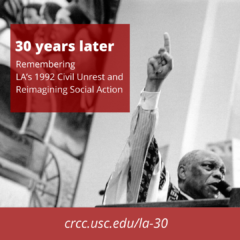In 1965, the LAPD’s beating of a Black man—Marquette Frye—unleashed pent-up rage at police brutality and economic injustice in the city’s African American community, sparking the Watts Riots. Burned-out buildings from that period of civil unrest marred the landscape of South Los Angeles as late as the 1980s. While the beating of Rodney King in 1991 and the acquittal of the LAPD officers who brutalized him a year later are widely assumed to have been the inciting incidents for the 1992 civil unrest, another, less widely reported story also provided tinder for the flames. Fifteen-year-old Latasha Harlins was shot in the back of the head by a Korean convenience store owner two weeks after the video of Rodney King’s beating was made public. Then a suspended sentence for Harlin’s convicted killer was upheld, allowing the killer to walk free, about a week before Rodney King’s LAPD assailants were acquitted.
These layers of history, trauma and injustice were apparent to the researchers who produced “Politics of the Spirit,” a scholarly account of faith-based networking and organizing in the aftermath of the 1992 civil unrest.
Read “Politics of the Spirit”
First African Methodist Episcopal Church (better known as FAME) in Los Angeles became the de facto headquarters of efforts to manage the city’s collective hurt and outrage following the acquittal of King’s assailants. As the fires burned, the church had opened its doors to the community, media and officials, providing services and mediating between various stakeholders:
During these terrifying hours, television cameras focused on events at the First African Methodist Episcopal Church, located just off Adams Boulevard in South Central Los Angeles. It was here that Mayor Tom Bradley expressed his outrage at the verdicts delivered in the Rodney King trial by an all-Caucasian jury, which had deliberated in a courtroom barely thirty freeway miles from South Central, yet in another, psychologically distant world.
It was also here in the First AME Church that the Reverend Cecil Murray instantly emerged as the anointed media voice for the city’s minority populations. Speaking out of memories of the 1965 Watts riots, with the demeanor of an individual who was skilled in the making of media events, Murray expressed frustration concerning the fundamental conditions that had kindled the night of fires. And then, in the spirit of the religiously-inspired American civil rights movement, with which he had long been associated, Murray invited the citizens of Los Angeles to join together in acts of reconciliation and healing.
On Sunday, May 3, 1992, the Rev. Cecil Murray addressed his congregation—including Mayor Tom Bradley, representatives from the LAPD and LA City Council, as well as other elected officials—from the pulpit of First African Methodist Episcopal Church (FAME). The electrifying sermon illuminated all of the elements that had provided tinder for the flames as well as the pathway out of the city’s violence and discord.
Watch Rev. Murray’s sermon during the civil unrest (transcript available here):
Significantly, “Politics of the Spirit” uncovered a liberationist ethic among faith groups responding to the civil unrest that crossed traditional conservative and progressive divides:
Liberal to middle-of-the-road religious institutions have tended to emphasize the importance of exercising political power on behalf of oppressed populations. They have been concerned about institutional bias against people who are politically weak. When they have spoken about liberation, they have generally meant political and economic liberation. Conservative religious communities, on the other hand, have emphasized spiritual transformation, one person at a time. They have believed that political systems will be transformed only when morally conscientious people oversee public institutions… Yet in Los Angeles’ religious communities, this distinction hardly makes any sense at all… In the neighborhoods that were most severely affected by the April 29, 1992 uprising, there is a theological coming-together of religious communities around liberationist themes.
That common sense of purpose among a diverse array of faith communities enabled the creation of new coalitions and networks to respond to the needs of marginalized people, both in times of crisis and over the longer term. This development is the key insight offered by “Politics of the Spirit” in the years immediately following the 1992 civil unrest:
Coalitions do not hold together around the production of media events. They hold together when everyone fixes on a concrete political or economic issue and agrees to work on it… We have begun to wonder whether the very title of our Religion and Civic Order project involves a redundancy. In Los Angeles’ central city neighborhoods, religion, by definition, now involves a wide range of human service activities. Religion, by definition, involves commitments to the building of congregation-based forms of civic infrastructure… Religious institutions can plan together. They can pool their resources. Together they can do a far better job in assuming new community-oriented roles than they can do separately.
Read the full report: “Politics of the Spirit”
Next: Find out more about The Rev. Dr. Cecil L. Murray, a pivotal figure in the unrest

